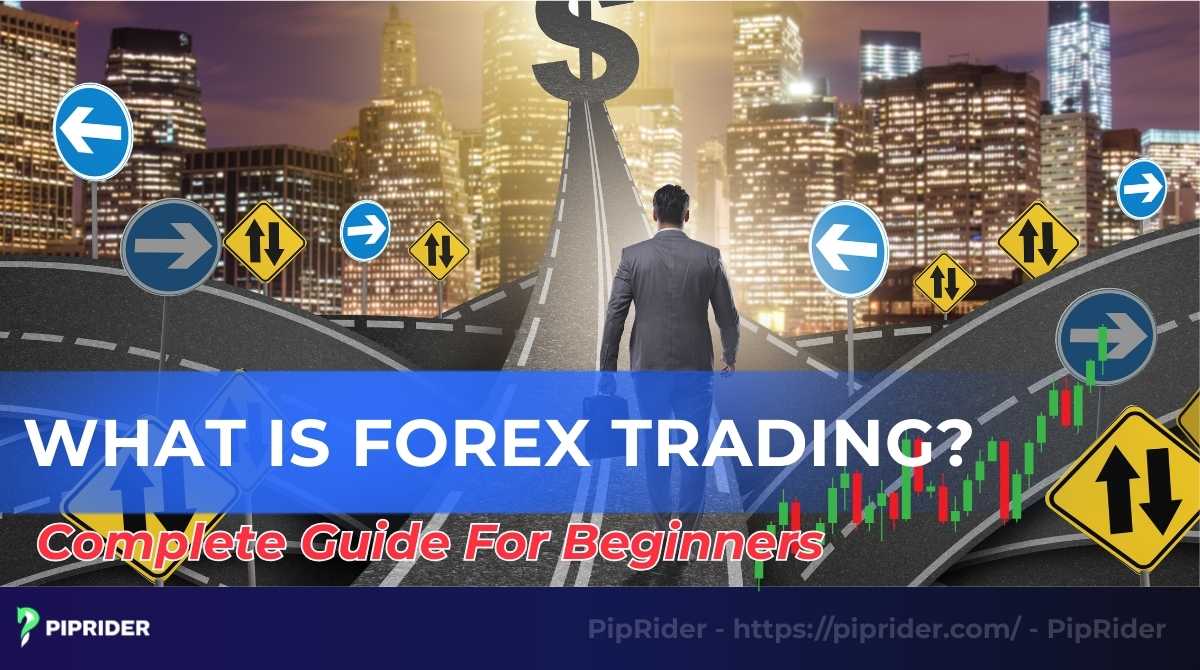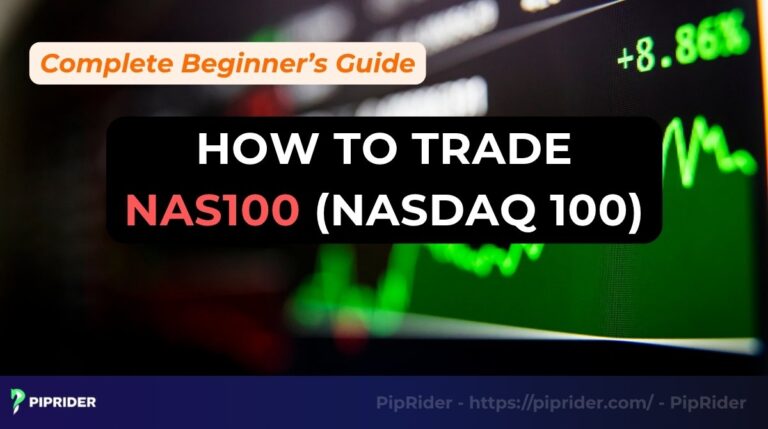Have you ever wondered how people profit from the fluctuations of currencies like the US Dollar, Euro, or Japanese Yen? Welcome to the world of Forex. Foreign exchange trading opens up immense financial opportunities, but it also comes with significant risks.
In this guide, the expert team at Piprider will provide you with a clear roadmap, explaining what Forex trading is, how it works, and the foundational strategies to help you confidently step into the largest financial market on the planet.
Key Takeaways
- Forex trading is the act of buying and selling currencies on the global market to profit from exchange rate differences.
- With a daily trading volume of over $7.5 trillion, the forex market operates 24 hours a day, 5 days a week.
- Major currency pairs like EUR/USD, GBP/USD, and USD/JPY account for the majority of trading volume.
- Popular forex strategies include scalping, day trading, and swing trading.
- The main risks come from the use of high leverage, strong market volatility, and trading psychology.
1. What Is Forex Trading?
Forex trading, or FX trading, is the exchange of one currency for another on the foreign exchange market with the goal of profiting from changes in their exchange rates. The main purpose of Forex trading is to profit from currency exchange rate fluctuations and for businesses to hedge against currency risk.
Its key features include being the world’s most liquid and decentralized financial market, operating 24/5. It also allows traders to use leverage to control large positions with small amounts of capital.
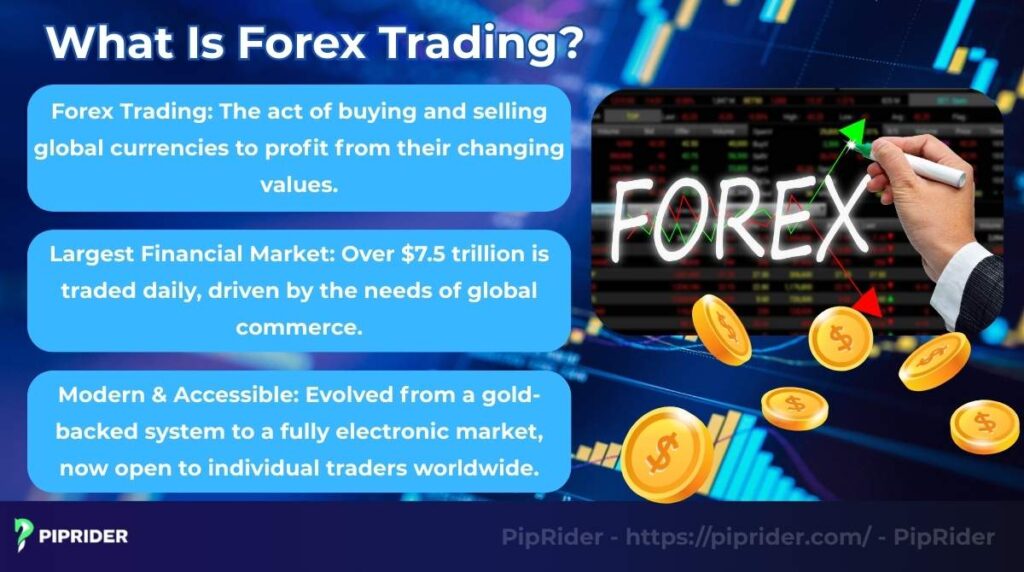
1.1. The evolution from Gold to a Digital Market
For much of recent history, currency values were fixed, first to the price of gold (the Gold Standard) and later to the US dollar. This changed in the 1970s when these systems were abandoned, allowing currencies to “float” freely against one another. The subsequent rise of the internet and electronic trading platforms made this global market accessible to individuals for the first time (Chen, 2025).
1.2. Why is Forex the world’s largest financial market?
The immense size of the forex market is driven by the fundamental needs of global commerce. Every international trade, from a corporation buying raw materials overseas to an investment fund moving capital, requires a currency exchange. This constant, large-scale need for currency conversion is what makes it the most liquid and active financial market on the planet, with the Bank for International Settlements (BIS) (2022) reporting a daily trading volume of over $7.5 trillion.
2. How Does Forex Trading Work?
At its core, forex trading is about exchanging one currency for another in the hope that the currency being bought will increase in value compared to the one being sold. This process has several key components that every beginner needs to understand.
2.1. The Concept of Currency Pairs
Currencies are always traded in pairs. When trading forex, there is a simultaneous act of buying one currency and selling another. Think of it like a constant tug-of-war between two currencies.
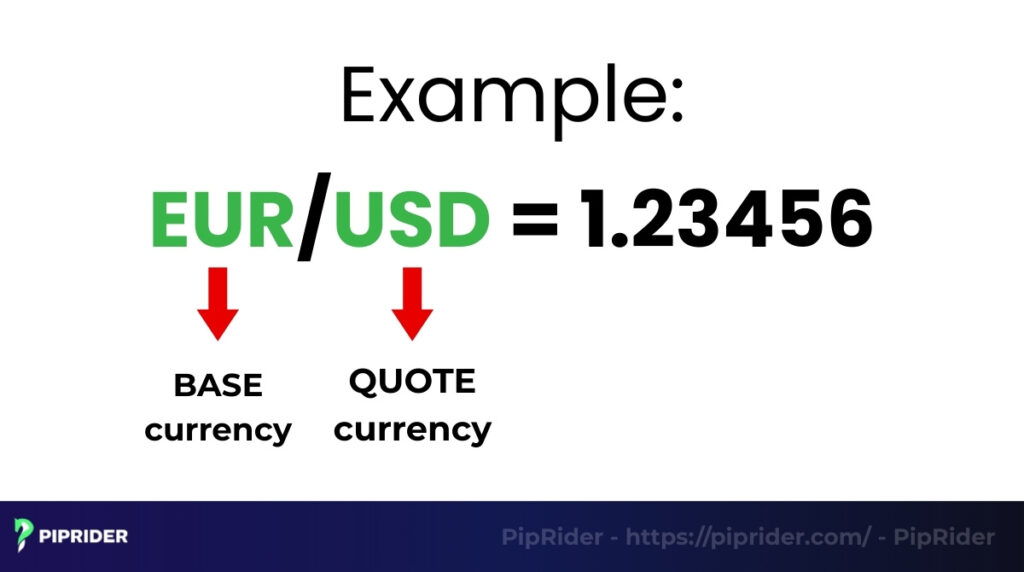
- Base & Quote Currency: The first currency in a pair is the base currency, and the second is the quote currency. The exchange rate shows how much of the second is needed to buy one unit of the base currency. For example, if the USD/JPY price is 150.00, it means 1 US Dollar costs 150.00 Japanese Yen.
- Pair Categories: There are 3 types:
| Category | Definition | Include |
| Majors | The most traded pairs in the Forex market. All major pairs always include the US Dollar (USD). | EUR/USD, USD/JPY, GBP/USD, AUD/USD, USD/CHF, USD/CAD, NZD/USD |
| Minors (or Crosses) | These are pairs of major currencies that do not include the US Dollar. | EUR/GBP, EUR/JPY, AUD/CAD, NZD/CAD |
| Exotics | A major currency paired with a currency from an emerging or smaller economy. These pairs have lower trading volume and higher volatility. | USD/MXN, EUR/TRY, GBP/ZAR, USD/SGD |
2.2. How Currency Values Change
The value of a currency fluctuates based on the simple principle of supply and demand. If demand for a currency is high (more people want to buy it), its value increases. The main drivers of this supply and demand include:
- Interest rate decisions from central banks.
- Economic data releases like inflation and employment reports.
- Geopolitical stability and major political events.
2.3. The Role of Brokers and Leverage
As a retail trader, a broker is needed to access the foreign exchange market. The broker provides a trading platform that allows for live price viewing, trade placement, and reliable trade execution.
Brokers also offer leverage, which is one of the defining features of forex trading.
- Leverage is like a loan from a broker: It allows a trader to control a large position in the market with a small amount of their own capital (known as margin). For example, with 100:1 leverage, one could control a $100,000 position (a standard lot) with just $1,000.
- Warning: It is crucial to understand that leverage is a double-edged sword. It amplifies potential profits, but it also equally amplifies potential losses.
2.4. Placing a Trade: Buy vs. Sell
In forex, traders can profit from both rising and falling markets.
- Going Long (Buy): A pair is bought if the first currency listed is believed to strengthen against the second.
- Going Short (Sell): A pair is sold if the first currency listed is believed to weaken against the second.
3. Key Players in the Forex Market
The forex market is a complex ecosystem with several different types of participants, each trading for different reasons. Understanding who these players are helps traders understand the forces that move currency prices.

| Player Category | Primary Motivation / Purpose | Estimated Market Share (Volume) |
| Central Banks & Governments | Stabilization/Management: To manage their country’s currency and stabilize the economy (not for profit). | < 5% |
| Commercial Banks & Institutions | Facilitation & Speculation: To facilitate client transactions and trade for proprietary profit. | 40-50% |
| Corporations | Commercial Necessity: To hedge foreign exchange risk and pay for international goods/services. | 10-15% |
| Retail Traders | Speculation: To profit from short-term and long-term currency price fluctuations. | < 10% |
3.1. Central Banks & Governments
These are the most powerful players. Central banks, like the U.S. Federal Reserve (Fed) or the European Central Bank (ECB), intervene in the forex market not to make a profit, but to manage their country’s currency and stabilize their economy. While they have an immense influence, their trading volume is relatively small, estimated at less than 5% of the total market share.
3.2. Commercial Banks & Institutions
This group represents the heart of the forex market. Large commercial banks and financial institutions facilitate the vast majority of currency trading volume, accounting for an estimated 40-50% of the total market. They trade for their clients and for their own speculative profit.
3.3. Corporations
Multinational corporations participate in the forex market out of necessity for their business operations, such as exchanging currencies to pay for goods and services from another country. Their trading volume is estimated to be around 10-15% of the market.
3.4. Retail Traders
Retail traders includes individuals accessing the forex market with their own capital through a retail broker. While retail traders represent the smallest volume share (less than 10% of the market), their role is unique. Their primary motivation is speculation, to profit from currency fluctuations, rather than commercial necessity.
Their small position size grants them a significant advantage in agility, allowing for immediate entry and exit with minimal market impact. Success for this group depends on leveraging this flexibility through rigorous risk management and disciplined trading plans, rather than competing directly with large institutions.
4. Advantages and Risks of Forex Trading
Like any form of investment, Forex market presents both significant opportunities and substantial risks. It’s crucial for beginners to understand both sides of the coin. Leveraged trading, in particular, requires careful management.
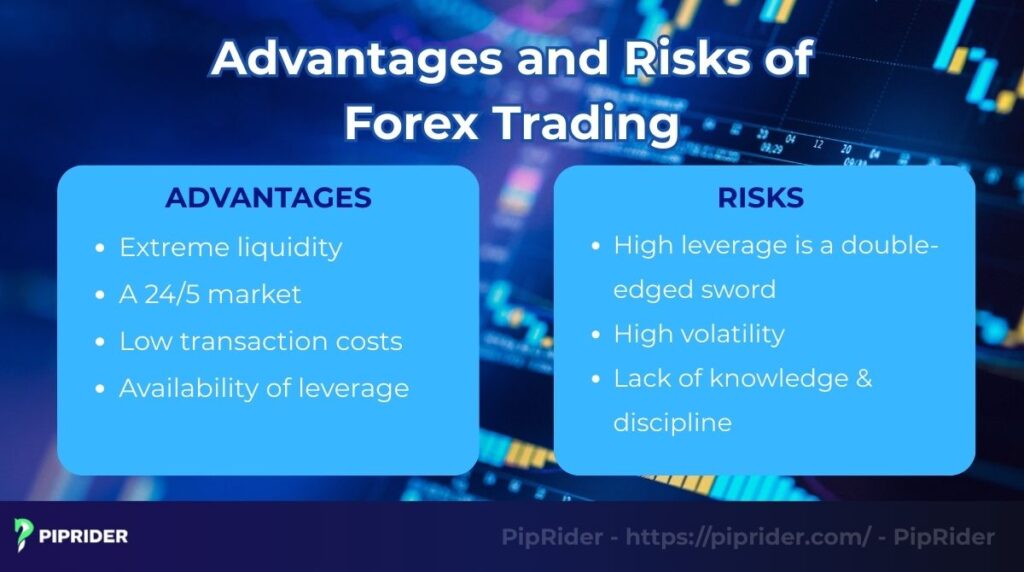
4.1. Advantages
The forex market is popular for several key reasons that attract traders globally. Here are some of its main benefits:
- Extreme liquidity: As the world’s largest market, traders can enter and exit trades almost instantly, especially with major pairs.
- A 24/5 market: The market operates around the clock from Monday morning in Sydney to Friday afternoon in New York, offering great flexibility.
- Low transaction costs: Most brokers don’t charge commissions; the primary cost is the spread, which is typically very low for major pairs.
- Availability of leverage: Leverage allows traders to control a large position with a small amount of capital, creating the potential for higher returns.
4.2. Risks
However, the same features that make forex attractive also create significant risks that must be managed. Here are the most critical ones:
- High leverage is a double-edged sword: Leverage amplifies losses at the same rate it amplifies profits, meaning a small adverse move can cause a large loss.
- High volatility: The market can move very quickly, especially during news events. Without a stop-loss, this can lead to rapid and substantial losses.
- Lack of knowledge & discipline: This is the biggest risk for new traders. Trading based on emotion rather than a clear plan is a primary cause of failure.
5. Popular Forex Trading Strategies
Choosing a Forex Trading Strategies depends on personality, available time, and risk tolerance. Here are five of the most popular approaches, from the very short-term to the long-term.

5.1. Scalping
Scalping is an extremely fast-paced strategy where traders aim to capture many small profits from tiny price movements.
- Holding Time: Seconds to minutes.
- Goal: To accumulate a large number of small wins throughout the day.
- Best for: Active traders who can dedicate intense focus, make rapid-fire decisions, and have a broker that offers fast trade execution.
5.2. Day Trading
Day trading is a strategy where all positions are opened and closed within the same trading day, ensuring no trades are left open overnight.
- Holding Time: Minutes to hours.
- Goal: To profit from intraday price movements without exposure to overnight risks.
- Best for: Traders who have time to analyze and monitor the markets during a specific session.
5.3. Swing Trading
Swing trading is a medium-term approach focused on capturing a single “swing” or a significant portion of a price move within a larger trend.
- Holding Time: Several days to a few weeks.
- Goal: To profit from larger market swings that play out over time.
- Best for: Traders with patience who may not have time to watch the charts all day.
5.4. Trend Trading
This is perhaps the most popular strategy in trading, built on the classic mantra: “the trend is your friend.” The core idea is to identify the market’s dominant direction (the trend) and only take trades that align with it, rather than trying to predict market tops and bottoms.
- Holding Time: Varies (can be applied to swing or position trading).
- Goal: To capture the main body of a market trend.
- Best For: Beginners, due to its straightforward and logical approach.
5.5. Position Trading
Position trading is the longest-term strategy, where trades are held for extended periods to capitalize on major, overarching market trends.
- Holding Time: Weeks, months, or even years.
- Goal: To profit from long-term shifts in economic fundamentals.
- Best for: Extremely patient traders who rely more on fundamental analysis than on short-term market noise.
6. Essential Tools and Technical Indicators in Forex
Successful forex traders are like skilled craftsmen; they have a toolbox of specific instruments. Beyond mastering indicators, they also learn to recognize forex trading chart patterns like Triangles or Head and Shoulders to predict future price moves.

6.1. For Identifying the Trend: Moving Averages
A Moving Average (MA) smooths out price data to provide a clear view of the underlying trend direction. A common method is to consider the trend bullish if the price is above a long-term MA (like the 200-period EMA) and bearish if it is below.
6.2. For Measuring Momentum: RSI & MACD
Momentum indicators measure the speed and strength of price movements.
- RSI (Relative Strength Index): This oscillator helps identify overbought (typically >70) and oversold (<30) conditions.
- MACD (Moving Average Convergence Divergence): The MACD’s histogram is excellent for visualizing momentum. Bars above zero indicate bullish momentum, while bars below indicate bearish momentum.
6.3. For Gauging Volatility: Bollinger Bands & ATR
Volatility indicators help traders see how “quiet” or “wild” the market is.
- Bollinger Bands: The bands contract when volatility is low (a “squeeze”) and expand when it is high.
- ATR indicator (Average True Range): The ATR is a crucial risk management tool. A higher ATR value suggests higher volatility and may require a wider stop-loss.
6.4. For Trading the News: The Economic Calendar
The Economic Calendar is a fundamental trading tool that schedules upcoming economic data releases, such as inflation reports, interest rate decisions, and employment figures. High-impact events (often marked in red) cause the most significant market fluctuations.
7. Risk Management in Forex
Protecting capital is more important than chasing profits. For successful trading and effective risk management, follow these three core rules:
- Use a stop loss & take profit: A Stop Loss should be used on every trade to define the maximum risk before entering. A Take Profit can be used to lock in gains objectively. These tools help remove emotion from trading.
- Never risk more than 1-2%: The golden rule is to never risk more than 1-2% of total capital on a single trade. On a $1,000 account, this means the maximum loss (defined by a stop loss) should be no more than $10-$20. This protects the usable margin.
- Discipline is everything: The best rules are worthless if they are broken due to fear or greed. The true key to success is having the discipline to follow a risk management plan without exception.
8. Frequently Asked Questions (FAQ)
9. Summary
Forex trading offers immense opportunities for traders globally, thanks to its high liquidity and 24/5 market access. However, the risks from leverage and high volatility demand a solid foundation of knowledge, a clear strategy, and strict risk management.
The recommended path for any new trader is to start by mastering the fundamentals, testing your strategies on a demo account, and only then applying real capital.
To continue building foundational knowledge, we encourage you to explore our other guides and educational resources in our Learn Forex category on Piprider.


